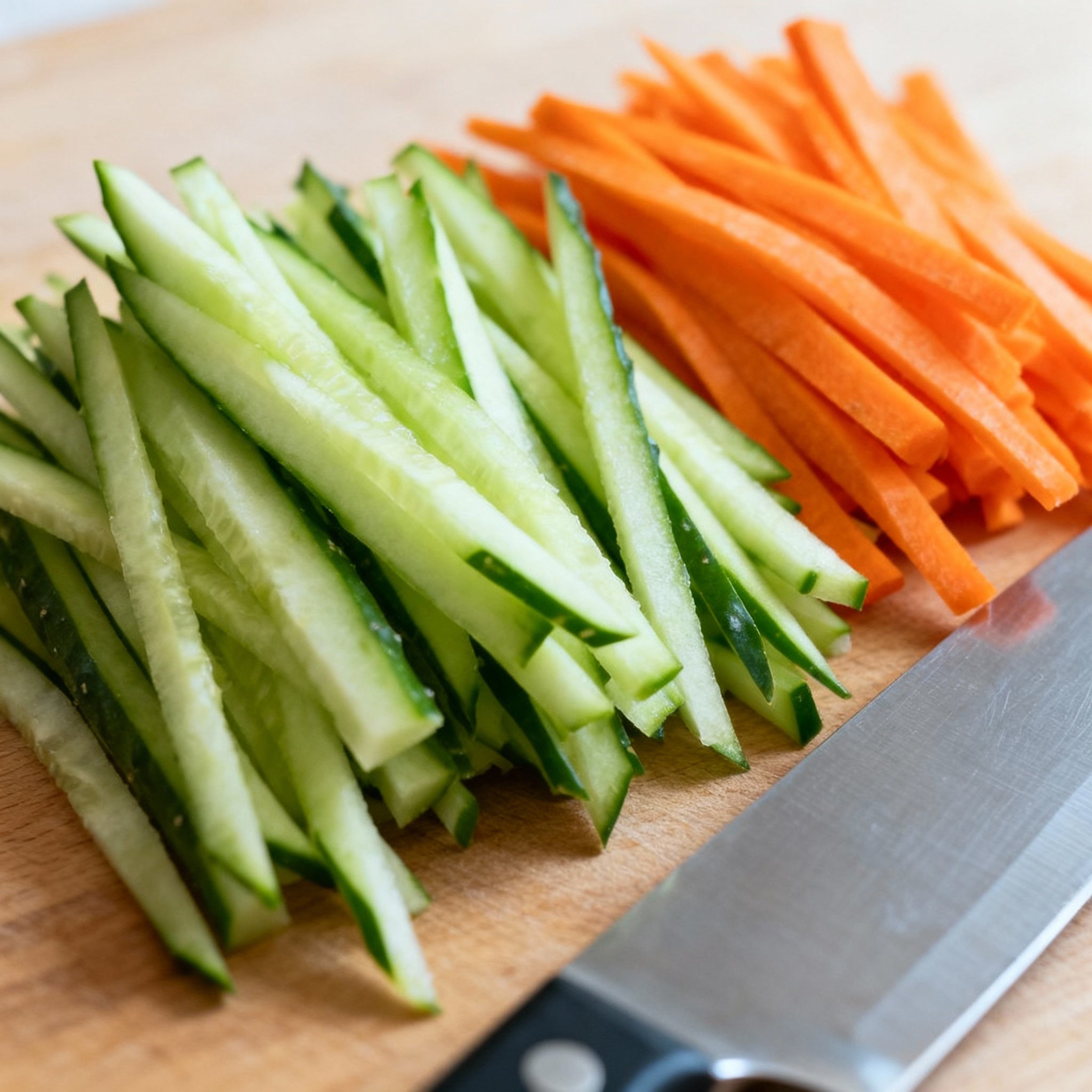If you’ve ever struggled with uneven cuts, slow prep times, or inconsistent food presentation, a mandoline vegetable slicer is a game-changer. This simple yet powerful tool helps chefs and kitchen teams produce razor-sharp, uniform slices in seconds—without the fatigue or inconsistency that comes with hand-cutting.
Whether you run a restaurant, café, catering business, or commercial kitchen, mastering the mandoline boosts speed, accuracy, and food presentation instantly.
TL;DR — Cut Faster, Safer, Smarter
-
Enhance Workflow: Choose the right blade and adjust thickness to create fast, consistent cuts that reduce prep time and minimise waste.
-
Increase Safety: Always use the safety guard or cut-resistant gloves to avoid injuries and keep quality high.
-
Maintain for Longevity: Wash, dry, and store your mandoline properly to keep blades sharp and hygienic for high-volume service.
Types of Mandoline Cuts (and When to Use Each One)
One of the biggest advantages of a commercial mandoline slicer is the wide variety of cuts it can produce. Swap the blade, adjust the thickness, and you instantly open up new possibilities for texture and presentation.
Straight Slices
Ideal for:
-
Salads
-
Potato chips
-
Gratin layers
-
Fruit platters
Straight slices ensure clean lines and even cooking.
Paper-Thin Slices
Perfect for:
-
Quick-cooking veg
-
Pickles
-
Carpaccio-style plating
Thin slices allow heat to pass through quickly for gentle, even cooking.
Julienne & Matchstick Cuts
Best for:
-
Slaws
-
Garnishes
-
Stir-fries
A julienne blade creates uniform strips with minimal effort.
French Fry Cuts (Thick Julienne)
Great for:
-
Chips and fries
-
Crispy root vegetables
Thicker cuts maintain structure while cooking.
Crinkle & Wavy Cuts
Ideal for:
-
Pickles
-
Wavy chips
-
Decorative sides
These cuts hold sauces and add visual appeal.
Waffle Cuts
Made by rotating the vegetable 90° between slices.
Perfect for:
-
Waffle fries
-
Decorative plating
How to Use a Mandoline Vegetable Slicer (Step-by-Step)
A mandoline saves time, boosts consistency, and produces professional results—but only when used safely and correctly. Here's your simple step-by-step guide.
1. Set Up Your Mandoline
-
Place it on a steady, flat surface.
-
A non-slip mat or damp towel beneath it increases stability.
-
Select your blade: straight, crinkle, wavy, julienne, or waffle.
Tip: Commercial mandolines are sharp—treat them like specialty chef knives.
2. Adjust the Thickness
Dial in your desired slice thickness BEFORE starting.
-
Thin for garnishes
-
Medium for salads
-
Thick for fries
Consistency = better cooking times + better food cost control.
3. Prep Your Ingredients
Trim and wash all produce.
Mandolines slice:
-
Apples
-
Carrots
-
Cucumbers
-
Potatoes
-
Cabbage
-
Zucchini
-
Fruits for tarts
-
Veg for stir-fries
Ensure the ingredient sits flat against the holder or guard.
4. Always Use the Food Guard
Never skip this step.
The guard:
-
Protects your fingers
-
Pushes produce evenly
-
Keeps cuts consistent
Cut-resistant gloves are highly recommended in commercial kitchens.
5. Slice With Smooth, Even Pressure
-
Hold the mandoline steady.
-
Push the guard down the blade in controlled strokes.
-
Avoid tilting or jerking motions.
This creates clean, uniform slices every time.
6. Clean and Store Carefully
-
Hand-wash in warm, soapy water.
-
Dry immediately to prevent rust.
-
Store with blade guards or covers.
Safety Measures When Using a Mandoline Slicer
Mandolines are incredibly sharp, which is why proper technique is essential.
Always:
✔ Use the safety guard
✔ Wear cut-resistant gloves (especially with wet/slippery ingredients)
✔ Keep the slicer steady on a non-slip surface
✔ Focus—avoid multitasking
✔ Handle blades from the SIDES, never the cutting edge
These habits make mandolines safer than knives for many prep jobs.
Cleaning & Maintenance Tips to Extend Lifespan
A well-maintained mandoline stays sharp, sanitary, and reliable.
-
Hand-wash after each use
-
Dry thoroughly to prevent rust
-
Store safely with blade covers
-
Check blade sharpness monthly in commercial environments
Replace or sharpen blades when slices become uneven or require force.
Recommended Mandoline Slicers for Australian Hospitality
Upgrade your kitchen with reliable, commercial-grade slicers from Hospitality Connect.
Brice – Chef’s Mandoline Slicer
-
Heavy-duty stainless steel
-
Built for high-volume prep
-
Multiple interchangeable blades
-
Non-skid stand + safety features
-
Ideal for restaurants and catering operations
Internal Link Suggestion:
➡️ Link to Brice Mandoline on Hospitality Connect shop
DeBuyer Mandoline Slicer
-
Precision-engineered in France
-
Known for ultra-sharp blades
-
Perfect for paper-thin cuts
-
Lightweight yet commercial-quality
-
Loved by chefs for accuracy and smooth slicing
Internal Link Suggestion:
➡️ Link to DeBuyer Mandoline
Conclusion
Learning how to use a mandoline vegetable slicer properly can transform your commercial kitchen. With correct blade selection, safe technique, and regular maintenance, you’ll enjoy faster prep times, reduced waste, and enhanced food presentation every day.
At Hospitality Connect, we supply Australian hospitality businesses with commercial-grade mandolines, kitchen tools, and expert advice to help your team work faster, safer, and smarter.
External Link Suggestion:
➡️ Learn more about safe food preparation practices (Food Standards Australia)
https://www.foodstandards.gov.au
Frequently Asked Questions
What must you always have when using a mandoline?
Always use the safety guard or food holder. A stable base (like a non-slip mat) is also essential for safe slicing.
What are the disadvantages of a mandoline?
-
Risk of cuts if the safety guard isn’t used
-
Requires careful cleaning
-
Some models have fewer blade options
-
Learning curve for beginners
How to use a mandoline for tomatoes?
Use a sharp straight or serrated blade.
Secure the tomato in the guard and apply gentle, even pressure to avoid crushing.
How do you use a mandoline for cucumbers?
Trim the ends, secure in the guard, set thickness, and slide smoothly down the blade.
You’ll get clean, consistent slices ideal for salads and garnishes.
Can I use a mandoline to slice potatoes?
Absolutely.
Use straight or crinkle blades depending on the cut you want, secure the potato, and slice evenly for chips, scalloped potatoes, or fries.










